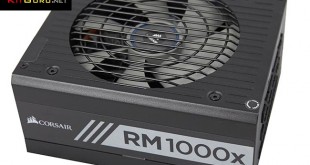
Corsair launch a new range of power supplies today, available in 550w, 650w, 750w, 850w and 1000w capacities. The new RMx series is fully modular, 80 Plus Gold certified and has been designed using all high grade Japanese 105c capacitors. Corsair claim tight voltage control and low noise levels thanks to the Zero RPM fan mode. Flat cables are also included, to make life easier during the build phase.
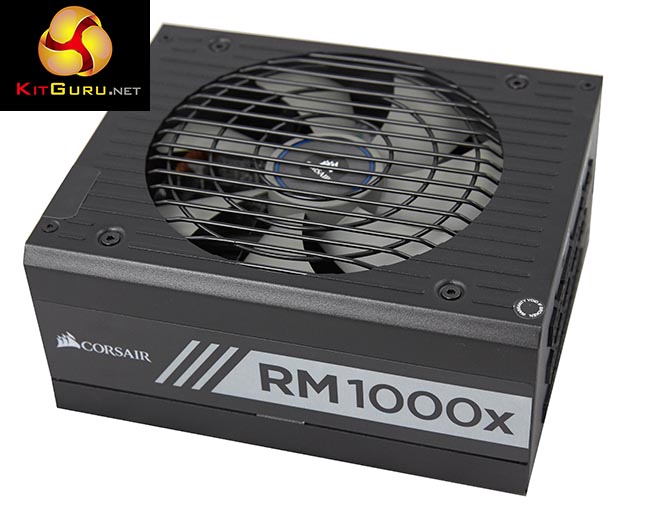
The Corsair RM1000x we test in this review slots right at the top of this particular series. All of these units are equipped with 135mm Rifle bearing fans and ship with an extended full 7 year warranty for peace of mind.
Corsair RMx overview:
- Zero RPM mode – offers silent operation at low to moderate loads.
- Optimised layout – for cooler operation and low noise.
- RMx Series Fan – rifled fan bearing: low noise, reduced resonance.
- Modular cables – Type 4 ‘flat' cables for stress free routing.
- Careful component selection – to help reduce vibration and coil whine.
- 80 Plus Gold Certification – reduced heat output.
- Reliable – 105c Japanese Capacitors incorporated.
- 7 year warranty – for added peace of mind.
UK/USA Pricing:
- RMx 550W – £69.99 / $109.99
- RMx 650W – £74.99 / $119.99
- RMx 750W – £92.99 / $129.99
- RMx 850W – £99.99 / $149.99
- RMx 1000W – £129.99 / $179.99
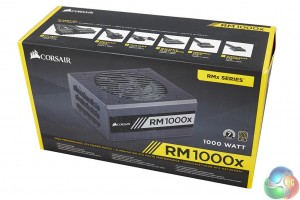
The Corsair RM1000x ships in an attractive yellow accented box with a high resolution image of the power supply visible in the center.
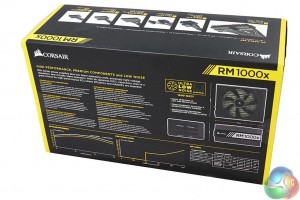
Along the top of the box, Corsair have focused on the cabling and at the rear they list the use of ‘premium components'. Fan noise is a clear focus for Corsair as they include a noise level chart and information on the silent operation.
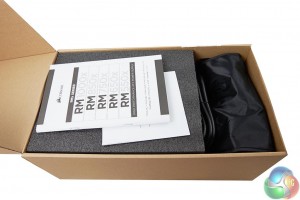
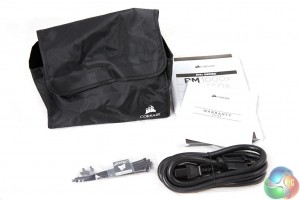
The power supply is protected inside thick foam with the cables at the side and the user manual on top. Corsair also include cable ties, case badge and a regional specific power cable.
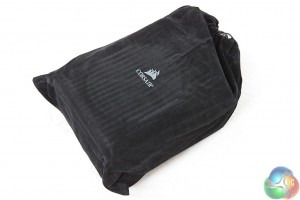
The power supply is protected inside a soft felt bag.
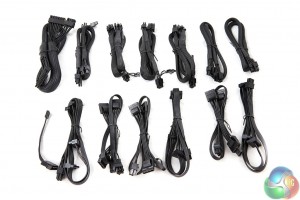
The RMx series ship with flat cables – these are the new ‘Type 4' standard. The 8 pin cables, for ATX12V/EPS12V and PCIe are pin compatible with Type 4 cables, but they have added capacitors to help reduce ripple noise.
The Type 4 24 pin cable has an additional four pins. These are ‘sense wires' which allow the RMx to measure the voltage at load and adjust on the fly, subsequently improving voltage regulation. Corsair have a page set up focusing on these cables, over HERE.
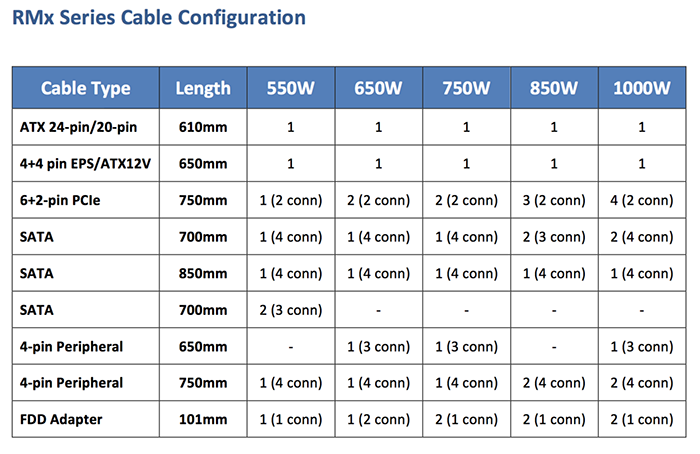
The RMx 1000W has a total of eight PCIe connectors across four cables – ideal for a Tri or Quad card SLi or Crossfire configuration. Unless you are using two R9 295X2's that is – we advise a 1500 watt power supply for this configuration.
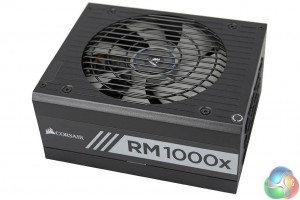
The Corsair RM1000x power supply is a rather simple looking, inoffensive, yet attractively finished power supply. The RM 1000x branding is visible on the side panels. It measures 150 mm (W) x 86 mm (H) x 180 mm (L).
Paint quality is high, and it passed our screwdriver test. This involves running the head of a Philips head driver down the side of the chassis with light to medium force. After all, how many times have you accidentally connected with a power supply during a system build?
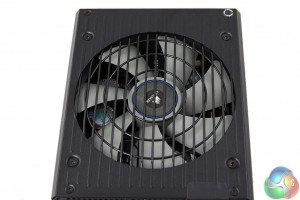
A large pale coloured fan is partially visible behind the metal grill – we will take a closer look at this when we open the unit shortly.
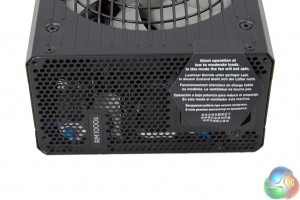
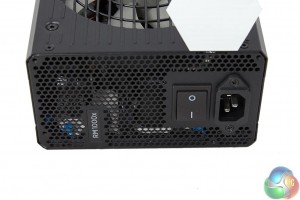
One side of the power supply is vented to help with heat dissipation and air flow. A power button and connector are positioned at the side. Corsair place a sticker over the cable connector to alert the user that the fan is not likely to spin at idle to moderate loads.
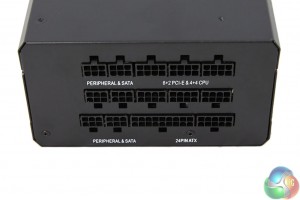
The modular panel is clearly laid out and labelled to avoid confusion during the build phase. The 1000W supply has an extra row of modular connectors (3) when directly compared with the 750W model.
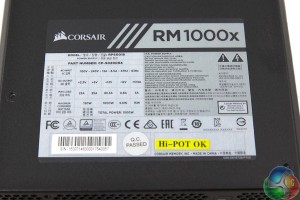
| Corsair RM1000x | |||||
|
DC Output
|
+3.3V
|
+5V
|
+12V |
-12V
|
+5Vsb
|
|
Max Output
|
25A
|
25A
|
83.3A |
0.8A
|
3A
|
| Total Power | 150W | 1000W | 9.6W | 15W | |
| 1000W | |||||
The power supply can deliver a whopping 83.3A via the +12V rail. The specifications above are actually identical to the RMi 1000W which we reviewed back in June. The RM1000x can deliver the full power over the +12V rail.
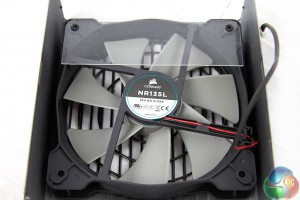
The RM1000x incorporates the NR135L 135mm fan – the same as the 750w unit. This is a rifle bearing fan rated at 0.22A. Corsair claim that a rifled bearing fan will provide longer life and quieter operation than ‘most' ball bearing fans. The blades of this fan are said to be properly balanced to help prevent resonance at higher speeds. There is a little plastic flap over part of the fan, to forceably direct the airflow across the hotter running components.
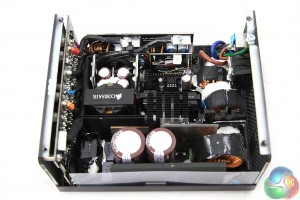
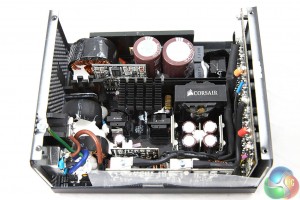
This is a CWT design for Corsair, and the build quality is very high indeed. Soldering is without fault and the component selection throughout is excellent. The layout seems well thought out for surface cooling too.
Corsair make the point that they have invested a lot of time into ensuring these units do not exhibit any ‘coil whine’. This can be caused by poor winding of a transformer or coil. Also the conducting and insulating layers of a capacitor can vibrate excessively if the components are not wound properly. These vibrations can lead to audible noise that many people class as ‘coil whine’.
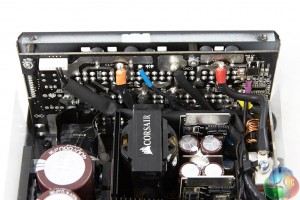
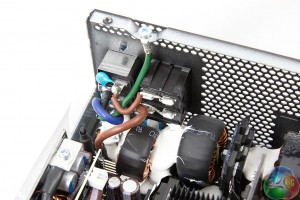
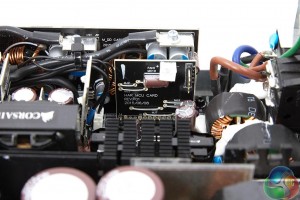
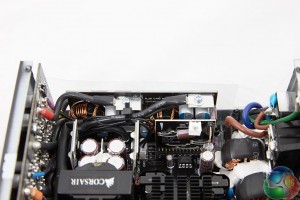
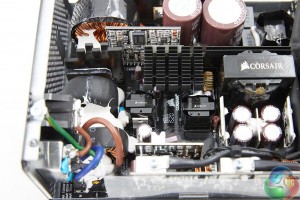
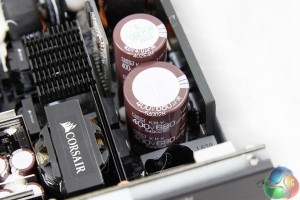
Corsair are using 105c rated Japanese capacitors on both primary and secondary stages. In the primary stage there are two different sized KMW series Nippon Chemi Con capacitors – one is rated 400v 680uF and the other 400v 470uF. This brings the total to 1150uF.
On this page we present some high resolution images of the product taken in our professional studio with a Canon 1DX camera. These will take much longer to open due to the dimensions, especially on slower connections. If you use these pictures on another site or publication, please credit Kitguru.net as the owner/source.
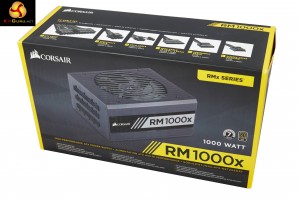
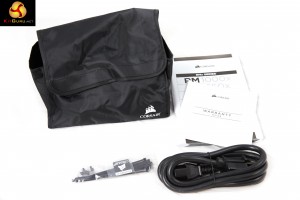
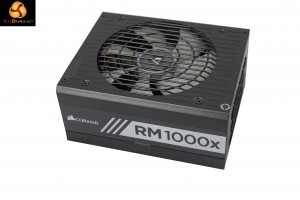
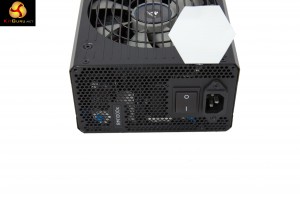
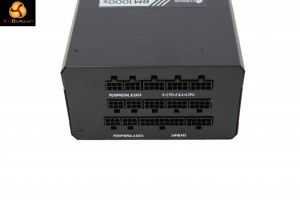
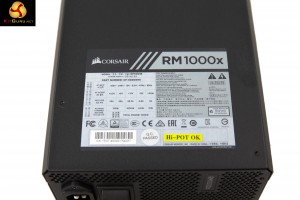
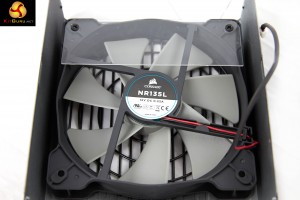
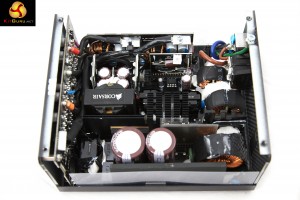
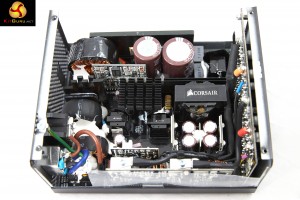
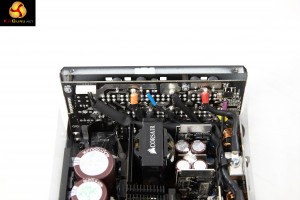
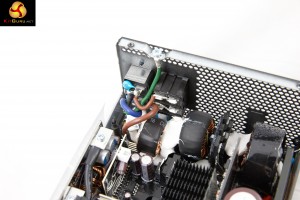
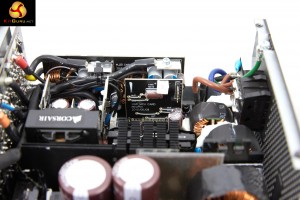
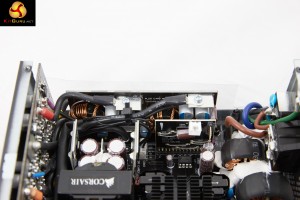
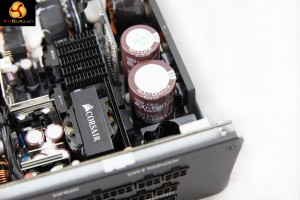
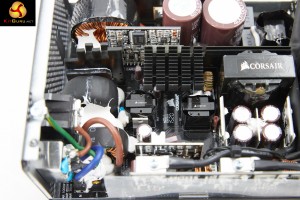
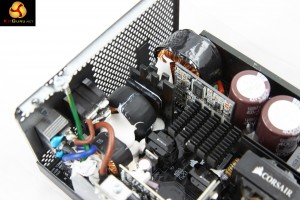
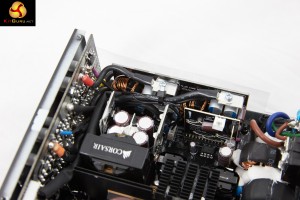 Additional technical assistance: Peter McFarland and Jeremy Price.
Additional technical assistance: Peter McFarland and Jeremy Price.
Correctly testing power supplies is a complex procedure and KitGuru have configured a test bench which can deliver up to a 2,000 watt DC load. Due to public requests we have changed our temperature settings – previously we rated with ambient temperatures at 25C, we have increased ambient temperatures by 10c (to 35c) in our environment to greater reflect warmer internal chassis conditions.
We use combinations of the following hardware:
• SunMoon SM-268
• CSI3710A Programmable DC load (+3.3V and +5V outputs)
• CSI3711A Programmable DC load (+12V1, +12V2, +12V3, and +12V4)
• Extech Power Analyzer
• Extech MultiMaster MM570 digital multimeter
• SkyTronic DSL 2 Digital Sound Level Meter (6-130dBa)
• Digital oscilloscope (20M S/s with 12 Bit ADC)
• Variable Autotransformer, 1.4 KVA
We test with the +12V in single rail mode.
|
DC Output Load Regulation
|
||||||||||
|
Combined DC Load |
+3.3V
|
+5V
|
+12V
|
+5VSB
|
-12V | |||||
|
A
|
V
|
A
|
V
|
A
|
V
|
A
|
V
|
A | V | |
|
100W
|
1.53
|
3.35
|
1.77
|
5.07
|
6.66
|
12.07
|
0.50
|
5.03
|
0.20
|
-12.03
|
|
200W
|
3.13
|
3.35
|
3.50
|
5.07
|
13.50
|
12.07
|
1.00
|
5.02
|
0.20
|
-12.04
|
| 400W |
6.42
|
3.35
|
7.04
|
5.07
|
27.50
|
12.06
|
1.50
|
5.02
|
0.30
|
-12.04
|
| 600W |
9.81
|
3.34
|
10.75
|
5.06
|
41.70
|
12.05
|
2.00
|
5.02
|
0.30
|
-12.05
|
|
800W
|
13.25
|
3.33
|
14.55
|
5.05
|
56.40
|
12.03
|
2.50
|
5.01
|
0.50
|
-12.05
|
| 1000W | 16.55 | 3.33 | 15.67 | 5.03 | 71.40 | 11.97 | 3.00 | 5.00 | 0.60 | -12.05 |
Load regulation is excellent, holding with 1.5%.
| Corsair RMx Series 1000W |
Maximum Load |
| 1103W |
We managed to get another 103 watts from the power supply before the protection circuitry kicked in. Great results.
Next we want to try Cross Loading. This basically means loads which are not balanced. If a PC for instance needs 500W on the +12V outputs but something like 30W via the combined 3.3V and +5V outputs then the voltage regulation can fluctuate badly.
| Cross Load Testing | +3.3V | +5V | +12V | -12V | +5VSB | |||||
| A | V | A | V | A | V | A | V | A | V | |
| 885W | 2.0 | 3.34 | 2.0 | 5.05 | 72.0 | 11.97 | 0.2 | -12.05 | 0.50 | 5.03 |
| 240W | 20.0 | 3.32 | 24.0 | 5.01 | 2.0 | 12.06 | 0.2 | -12.05 | 0.50 | 5.04 |
The unit passes the cross loading test with both +3.3V and +5V rails holding steady. The +12V rail droops a little when hit with 72A, but it is well within what we would expect.
We then used an oscilloscope to measure AC ripple and noise present on the DC outputs. We set the oscilloscope time base to check for AC ripple at both high and low ends of the spectrum. ATX12V V2.2 specification for DC output ripple and noise is defined in the ATX 12V power supply design guide.
|
ATX12V Ver 2.2 Noise/Ripple Tolerance
|
|
|
Output
|
Ripple (mV p-p)
|
|
+3.3V
|
50
|
|
+5V
|
50
|
|
+12V1
|
120
|
|
+12V2
|
120
|
|
-12V
|
120
|
|
+5VSB
|
50
|
Obviously when measuring AC noise and ripple on the DC outputs the cleaner (less recorded) means we have a better end result. We measured this AC signal amplitude to see how closely the unit complied with the ATX standard.
| AC Ripple (mV p-p) | ||||
| DC Load | +3.3V | +5V | +12V | 5VSB |
| 100W | 5 | 5 | 5 | 5 |
| 200W | 5 | 5 | 5 | 5 |
| 400W | 5 | 5 | 10 | 5 |
| 600W | 10 | 5 | 15 | 5 |
| 800W | 10 | 10 | 15 | 5 |
| 1000W | 10 | 10 | 15 | 10 |
Ripple suppression is excellent. All rails hold well within the industry rated tolerance levels. +3.3V and +5V peak at 10mV. +12V peaks at 15mV at 100% load.
|
Efficiency (%)
|
|
|
100W
|
87.32
|
|
200W
|
88.65
|
|
300W
|
90.23
|
|
500W
|
92.19
|
|
800W
|
91.69
|
| 1000W | 90.81 |
Overall efficiency results are very strong indeed, peaking at around 92% between a 500 watt and 600 watt load. This drops to almost 91% efficiency at full load.
We take the issue of noise very seriously at KitGuru and this is why we have built a special home brew system as a reference point when we test noise levels of various components. Why do this? Well this means we can eliminate secondary noise pollution in the test room and concentrate on components we are testing. It also brings us slightly closer to industry standards, such as DIN 45635.
Today to test the Power Supply we have taken it into our acoustics room environment and have set our SkyTronic DSL 2 Digital Sound Level Meter (6-130dBa) one meter away from the unit. We have no other fans running so we can effectively measure just the noise from the unit itself.
As this can be a little confusing for people, here are various dBa ratings in with real world situations to help describe the various levels.
KitGuru noise guide
10dBA – Normal Breathing/Rustling Leaves
20-25dBA – Whisper
30dBA – High Quality Computer fan
40dBA – A Bubbling Brook, or a Refrigerator
50dBA – Normal Conversation
60dBA – Laughter
70dBA – Vacuum Cleaner or Hairdryer
80dBA – City Traffic or a Garbage Disposal
90dBA – Motorcycle or Lawnmower
100dBA – MP3 Player at maximum output
110dBA – Orchestra
120dBA – Front row rock concert/Jet Engine
130dBA – Threshold of Pain
140dBA – Military Jet takeoff/Gunshot (close range)
160dBA – Instant Perforation of eardrum
|
Noise (dBA)
|
|
|
100W
|
<28.0
|
|
200W
|
<28.0
|
|
400W
|
<28.0
|
|
600W
|
29.9
|
| 800W | 33.4 |
| 1000W | 34.8 |
The NR135L 135mm fan doesn't spin until around 400-430 watts are demanded from the unit. In the last 250 watts of power, it gradually spins up until full load, when it is generating around 35dBa of noise. This fan is clearly spinning faster in the RM1000x than it does in the RMx 750W at full load.
|
Temperature (c)
|
||
|
Intake
|
Exhaust
|
|
|
100W
|
35
|
38
|
|
200W
|
35
|
44
|
|
400W
|
37
|
46
|
|
650W
|
43
|
49
|
|
800W
|
45
|
54
|
| 1000W | 47 | 61 |
Temperatures are well controlled throughout the power range.
|
Maximum load
|
Efficiency
|
|
1105W
|
89.91
|
Pushing the power supply above its rated limits generates an efficiency level of around 89.91%. This is not a viable ‘real world’ situation, but its interesting nonetheless.
Corsair already have a wide range of power supplies available for the enthusiast audience as you can see if you look at this listing page on Overclockers UK. Their updated RMi series was launched in June this year with Corsair Link Support. The RMx units are supplementary to the RMi series – both have 80 Plus Gold Certification and are modular, however the RMx series do not have Corsair Link Support which will enable the company to hit slightly more competitive price points.
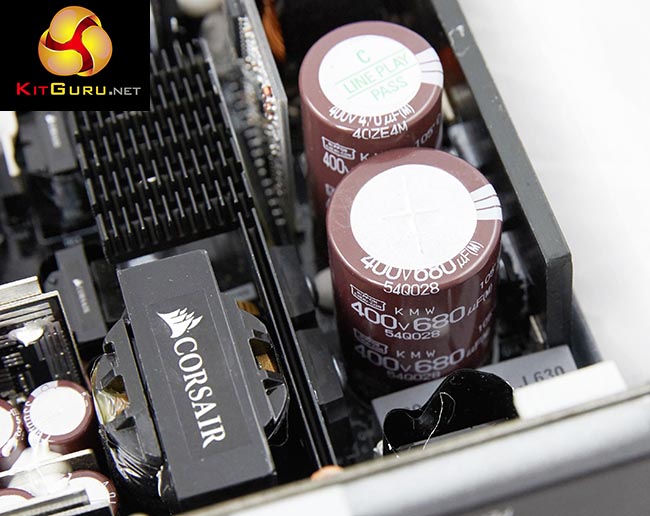
The RMx has been updated to incorporate 100% Japanese capacitors in both primary and secondary stages. The RM series only had Japanese capacitors in the Primary stage. The RMi series has a 140mm fluid dynamic bearing fan which in our tests proved to be a little quieter than the Rifle bearing featured in both RM and RMx units. To be fair, both units are relatively quiet and seem built to last. Corsair seem confident in the design and have increased the warranty from the RM series 5 years coverage to a full 7 years.
Alongside our testing of the RM750x today, the RM1000x is a solid, capable CWT design which doesn't compromise on component selection or overall build quality. Load regulation is stellar and the power supply achieves the 80 Plus Gold standard without a problem.
The new ‘Type 4' flat cables will appeal to the demanding enthusiast audience. The 8 pin cables for the ATX 12V/EPS12V and PCIe are pin compatible with Type 3 cables but they incorporate capacitors to help reduce ripple noise. This is actually one of the big selling points for the RM1000x – the class leading ripple suppression which is as good as we have seen. The results are very similar between this unit and the RM750x unit.
Lastly, the external finish meets the standards we would expect from Corsair and the fully modular design will appeal to enthusiast users who want to showcase an attractive, tidy build behind a windowed panel.

We are waiting on Overclockers UK to list the Corsair RM1000x to get confirmed pricing, but in the meantime head to THIS page, which lists all Corsair power supplies currently available. Corsair have told us that the RM1000x price will be set at £129.99 / $179.99.
Discuss on our Facebook page, over HERE.
Pros:
- great build quality.
- all 105c Japanese grade capacitors.
- ripple suppression.
- type 4 cables.
- low noise.
Cons:
- Corsair have so many supplies available right now, we think some people will be confused on which they need.
Kitguru says: The high power RM1000x delivers great load regulation, ripple suppression and achieves 80 Plus Gold Certification. The low noise NR135L fan only switches on when the load reaches 400watts, or higher. At £130 it is very competitively priced.

 KitGuru KitGuru.net – Tech News | Hardware News | Hardware Reviews | IOS | Mobile | Gaming | Graphics Cards
KitGuru KitGuru.net – Tech News | Hardware News | Hardware Reviews | IOS | Mobile | Gaming | Graphics Cards

